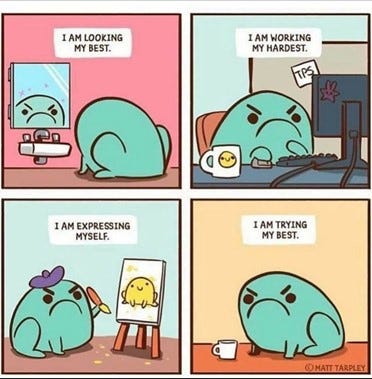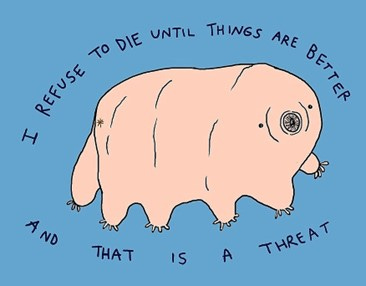The Science of Using Threatening Messages for Positive Thinking
Why “be positive” is the worst possible advice and the menacing internet trend that offers a better message
I’m not a violent person, but nothing compels me to take off my earrings, grab an imaginary knife, and mentally stab someone in the eye quite like the suggestion:
Be positive! Let go and let God.
My ears rang with this frustrating advice during early sobriety. I’d smile politely and thank the person for such an insightful response while inwardly rolling my eyes. Admittedly well-meaning, the suggestion was low-key condescending for several reasons:
Hello! Don’t you think I’d “be positive” if I could? I’m a fairly capable person.
What does “be positive” even look like? Give me the exact blueprints.
Since when are you the positivity police? I’m well within my rights to be annoyed right now. I know, I’m a lawyer.
Where has God been all this time? His management skills are clearly lacking.
After hearing this phrase for weeks on end, I felt demoralized and exhausted. Then, one day, scrolling mindlessly on Instagram, I saw a meme that provided the same advice with better messaging:

I was instantly delighted — the unapologetic threats were surprisingly uplifting.
I felt simultaneously supported and intimidated, a strangely winning combination.
This flavor of belligerent hopefulness belongs to a larger movement called ominous positivity, which originated around 2019 in the obscure recesses of Tumblr. After reaching mainstream visibility on Facebook, it now saturates the internet.
My amusement fascinated me. Why do I enjoy being frightened into blissful submission? After much research and reflection, I discovered the reasons for its appeal.
1. It supports the mind’s negative inclination

The brain is peculiar. It’s capable of fearless speculation yet somewhat timid. A study in the publication Nature Communications shows that it values certainty above all else.
In the study, participants played a computer game to uncover rocks that might have snakes hidden under them. When a snake appeared, they received a painful electric shock. Researchers altered the likelihood of encountering a snake in each session and asked participants to estimate the risk. They discovered that stress levels reached their highest point when participants perceived a 50% risk (equivalent to a matter of chance).
This implies that experiencing predictable negativity is less stressful than facing an equal chance of either a positive or negative outcome.
Think about it—we’d rather experience certain discontent than potential happiness. That’s bananas!
Ominous positivity conveys the message with reluctance, deceiving our subconscious into believing it’s accepting a negative outcome, which it finds comforting.
It surreptitiously changes the risk calculus by trading predictable negativity for acceptable positivity.
2. It diminishes negativity bias

Neuroscience demonstrates the brain has a finite capacity to process the extensive sensory inputs of everyday reality. Research indicates that to aid survival; the brain allocates more resources to catalog adverse events than positive ones. As neuroscientist Rick Hanson stated in the book Buddha’s Brain:
Your brain is like Velcro for negative experiences and Teflon for positive ones.
In addition, trauma survivors who’ve experienced events outside their control over-identify with negativity, promoting pessimism.
Optimists view unpleasantness as temporary and local — “This particular situation was difficult, so that specific attempt was unsuccessful.” In contrast, pessimists perceive similar circumstances as global — “This situation shows all attempts are difficult, proving I always fail at everything.”
Ominous positivity challenges the basis of negativity bias by offering an alternative perspective.
Past failures or traumas don’t dictate future successes because every event is situational, not universal. By embracing this viewpoint, you can dismiss your pessimism as an unfounded, fear-based response.
3. It encourages self-compassion

Rumination is passively dwelling on negative feelings and consequences. According to impaired disengagement theory, it’s most prevalent among individuals with depression and anxiety, hindering their ability to disengage from negative thoughts.
Studies show that intentionally focusing on pleasant or neutral activities (distraction) or purposely observing thoughts as passing mental events (mindfulness) significantly decreases rumination. I practice mindfulness and find it incredibly compelling. It teaches you to distinguish between your thoughts and your identity, decreasing self-judgment based on unfounded ruminations.
Now, this is all well and good, but asking your mind to disregard the present moment and fabricate an alternative reality is tantamount to telling your nose not to smell trash. Doing so requires intentional action riddled with fits, starts, and regression. Like the frog in the meme, change requires us to take action despite our internal state or unpleasant life circumstances.
Therefore, ominous positivity depicts optimism not as a switch but as a dial that changes gradually through consistent effort.
It urges you to exercise self-love and grace as you endure the incremental nature of such a massive paradigm shift. It reminds you that you deserve the space and compassion to be human.
4. It inspires grit and initiative
In her book Grit: The Power of Passion and Perseverance, psychologist Angela Duckworth contends that success is predicated on tenacity, not aptitude, which is a learned behavior available to anyone at any time. Therefore, irrespective of predisposition, you can develop grit with persistence.
This idea is consistent with the theory of neuroplasticity, which posits that neuronal circuits can change and reorganize in response to repetitive external and internal stimuli.
Duckworth maintains that cultivating grit necessitates passion toward an objective because fulfillment motivates resilience.
Emotional stamina demands a singular passion: self-love.
Ominous positivity empowers you to do positive things, not just be positive.
Action is a necessary prerequisite for lasting change because it relieves discomfort long enough to promote endurance and solidify a more supportive paradigm.
While transitioning mental states, you should persist in the new narrative despite your Ego’s protestations. From personal experience, you can reduce rumination through positive self-talk and somatic techniques. This has a cascading effect on your entire self-concept — the thrill of empowerment surpasses the comfort of victimhood.
In essence, positivity breeds more positivity, accumulating over time. The compound interest creates a feedback loop that reinforces the new positive attitude, enhancing the probability of future achievement.
Suddenly, success is not simply aspirational — it’s a birthright.

Pronoia is the antithesis of paranoia — the universe conspires for your benefit, not detriment. While the advice “Be positive. Let go and let God” conveys this message, it encourages passivity by failing to offer actionable guidance.
In contrast, ominous positivity promotes the same worldview with greater vigor and specificity:
Suspend your disbelief and assume a positive outcome.
Dismiss your inaccurate worldview to actively shift your perspective.
Exercise compassion as you slowly cultivate a more positive outlook.
Persist in the new narrative of self-love to create a mechanism for future success.
Fundamentally, ominous positivity suggests not taking life or yourself too seriously. It releases the pressure of perfection. It’s honest.
Now, whenever I feel hopeless, I empower myself by crafting a perfectly ominous message to my subconscious:
Seriously, mind, get a job. You’re living rent-free in my head and wasting all the energy in my brain. Also, take a shower — your thoughts stink.
Since I love myself, I’ll gladly force you. That’s an ominous promise!









Love this!
Negativity bias or our default to negative thinking-is what kept us alive in a world where everything was possibly capable of killing us. If we were wary of everything, we’d stay alive. It was a survival mechanism. The issue now is not everything we encounter or that happens to us is life threatening, but we keep wanting to think negatively because it comforts us due to our history.
Being positive takes effort. Not the denial that is now called toxic positivity, but the desire to override the negative bias so things can be positive more often. It’s hard work, but good work. When your perspective changes, so does your world. ❤️